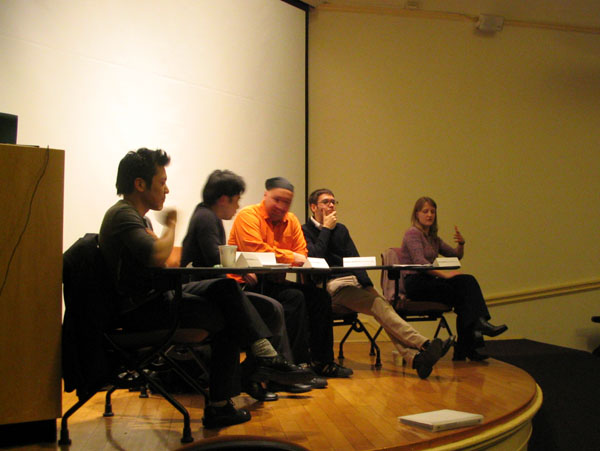Another Expo Platform in New York: Feb 16th, 2005 at New York University Einstein Auditorium
Panelists
Shinya
Watanabe (Spiky Art Curator)
Yuken Teruya (Artist from Okinawa)
Bozidar Boskovic (Curator from Belgrade)
Vesa Sahatciu (Curator, Kosovo Art Gallery)
Nebojsa Seric-Shoba (Artist from Sarajevo)
|
|
|
|
|
|
|
|

View of the Discussion
A Challenge to Connect Okinawa = Sarajevo = Belgrade = Kosovo i2005/2/18j
Shinya Watanabe
A challenge to connect Okinawa = Sarajevo = Belgrade = Kosovo beyond nation-states basically ended up as a big success. The panelists who do not know each other could comment a lot on one theme gnation-state,h and it happened probably because of the unique background of panelistsf hometown from beginning to the end.
Yuken Teruya told about his Okinawan style Bingata kimono artwork gYou-I, You-I.h The motif of this kimono is the new U.S. Air Force heliport which will be constructed in Henoko, Okinawa, and this motif itself was completely a new thing for all of the American audiences. This new heliport will threaten the habitat of dugong (manatee), and in this work, these objects are depicted as a same size. To threat these completely different objects in one size, I could felt something such as Teruyafs attitude toward these objects and its theme. Moreover, Teruyafs attitude which tries to overcome the difficulty to connect the contemporary arts with traditional bingata technique, the participating students who are dreaming to be artists might be aspired.
An artist Shoba from Sarajevo is from extremely mixed family, and during the siege of Sarajevo from 1993 to 1995, he fight against Serb military as a soldier. When he had a off of military duty, he returned to the studio in Sarajevo, and created some art work. However, he got such a huge mental difficulty by this extreme situation.
When he was in the trench at the front line during the war, he tried to create Piet Mondriaanfs Broadway Boogie Woogie by trench. However, because of that, he was judged by Bosnian military court.
The story of the person who experienced war such as Shoba was very significant. These real stories are beyond imaginations, especially for the people who have not experienced war. Especially it would have a large influence toward Teruya, since his motif is also war-related things.
Boshko, a Serb curator, left Belgrade at the age of 18 and went to Paris to study art history in 1995. Then, he moved to the United States and completed masterfs program, and became a curator. The reason why he left to Paris is that his parents were afraid that Boshko will be drafted for army and fight in the front line, so the parents sent Boshko to Paris before the situation get worse. However, while Boshko was in Paris, he prejudiced as Serb, as the aggressorfs side in wartime, and it became a big pressure for him. After coming to the United State and majored in art history, he said that he became extremely sensitive toward the cliche of what Balkan has in the outside of Balkan.
During the war, he was abroad, and his position as Serb from Belgrade and did not experience war is similar to the one of Marina Abramovic, and in fact, Boshko and Marina had a lot to share about these common experiences.
Vesa might be only one contemporary art curator who is active in Kosovo. She left Kosovo to New Zealand as a refugee in 1999, when Kosovo war started. Then she studied art history at a university in New Zealand, and after the graduation, she returned to Kosovo and worked as a curator for one and half a year.
Kosovo is the area which has an influence of Islamic culture and communism, and fine-arts education at there is pretty old style, and thatfs why media art did not emerged until 1999.
The artwork which is called one of the earliest video artwork in Kosovo in 1999 is "white map/blood to the knee" by Lulzim Zeqiri. In this video, there is a man who plays a stringed instrument called gusle, and his knee become flooded by blood-like red water. The motif gblood to the kneeh comes from the old word of Albania, but the topic was too national and I barely understand the theme. Vesa said, "Kosovo is creating the new identity now," and it was interesting.
Understanding the others and their experiences is directly connects to overcome the structure of nation-state, which is the concept of "Another Expo." The concept of the nation and nationalism which forms a nation-state appears when the idea of others were completely eliminated. However, to understand others is not so easy. It is because of the experience of oneself, language structure and so on.
It is extraordinary pleasure that the creation of "Another Expo" became visible as a form of platform in New York. As the first platform, I earnestly hope that platforms in Japan go well such as this one in New York.
Another Expo Exhibition in New York
August 15th, 2005 to September 10th, 2005
Sejla Kameric's new work "Sejla-san / ZC ² / Sejla Dream" is Here
Another
Expo Exhibition in Kitakyushu
June 18th, 2005 to July 1st, 2005
Another
Expo related lectures in Kyoto
Another Expo Platform in Tokyo
Another Expo Platform in Okinawa
Another Expo Platform in Nagoya
(Copyright: Shinya Watanabe)